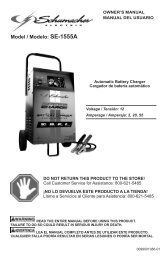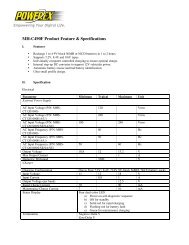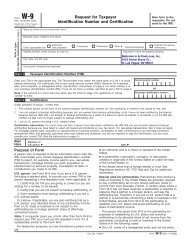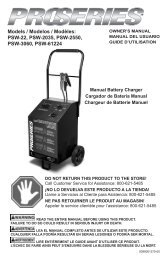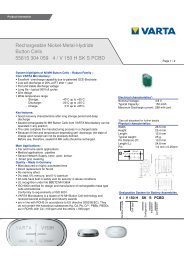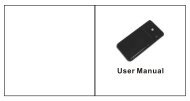Model / Modelo: SE-1072 - Schumacher Electric Corporation
Model / Modelo: SE-1072 - Schumacher Electric Corporation
Model / Modelo: SE-1072 - Schumacher Electric Corporation
You also want an ePaper? Increase the reach of your titles
YUMPU automatically turns print PDFs into web optimized ePapers that Google loves.
1.111.122.2.32.42.52.62.72.82.92.102.113.3.33.4RISK OF EXPLOSIVE GA<strong>SE</strong>S.1.10 WORKING IN THE VICINITY OF A LEAD-ACID BATTERY ISDANGEROUS. BATTERIES GENERATE EXPLOSIVE GA<strong>SE</strong>S DURINGNORMAL BATTERY OPERATION. FOR THIS REASON, IT IS OF UTMOSTIMPORTANCE THAT YOU FOLLOW THE INSTRUCTIONS EACH TIME YOUU<strong>SE</strong> THE CHARGER.To reduce the risk of a battery explosion, follow these instructions and those publishedby the battery manufacturer and the manufacturer of any equipment you intend to usein the vicinity of the battery. Review the cautionary markings on these products and onthe engine.This charger employs parts, such as switches and circuit breakers, that tend toproduce arcs and sparks. If used in a garage, locate this charger 18 inches or moreabove floor level.PERSONAL PRECAUTIONSRISK OF EXPLOSIVE GA<strong>SE</strong>S.2.1 NEVER smoke or allow a spark or flame in the vicinity of a battery or engine.2.2 Remove personal metal items such as rings, bracelets, necklaces andwatches when working with a lead-acid battery. A lead-acid battery can producea short-circuit current high enough to weld a ring or the like to metal, causing asevere burn.Be extra cautious, to reduce the risk of dropping a metal tool onto the battery. It mightspark or short-circuit the battery or other electrical part that may cause an explosion.Use this charger for charging LEAD-ACID batteries only. It is not intended to supply powerto a low voltage electrical system other than in a starter-motor application. Do not usethis battery charger for charging dry-cell batteries that are commonly used with homeappliances. These batteries may burst and cause injury to persons and damage to property.NEVER charge a frozen battery.NEVER overcharge a battery.Consider having someone nearby to come to your aid when you work near alead-acid battery.Have plenty of fresh water and soap nearby in case battery acid contacts your skin,clothing or eyes.Wear complete eye and body protection, including safety goggles and protectiveclothing. Avoid touching your eyes while working near the battery.If battery acid contacts your skin or clothing, immediately wash the area with soap andwater. If acid enters your eye, immediately flood the eye with cold running water for atleast 10 minutes and get medical attention right away.If battery acid is accidentally swallowed, drink milk, the whites of eggs or water. DO NOTinduce vomiting. Seek medical attention immediately.PREPARING TO CHARGERISK OF CONTACT WITH BATTERY ACID. BATTERY ACID IS AHIGHLY CORROSIVE SULFURIC ACID.3.1 If it is necessary to remove the battery from the vehicle tocharge it, always remove the grounded terminal first. Make sure allof the accessories in the vehicle are off to prevent arcing.3.2 Be sure the area around the battery is well ventilated whilethe battery is being charged.Clean the battery terminals before charging the battery. During cleaning, keep airbornecorrosion from coming into contact with your eyes, nose and mouth. Use baking sodaand water to neutralize the battery acid and help eliminate airborne corrosion. Do nottouch your eyes, nose or mouth.Add distilled water to each cell until the battery acid reaches the level specified by thebattery manufacturer. Do not overfill. For a battery without removable cell caps, suchas valve regulated lead acid batteries (VRLA), carefully follow the manufacturer’srecharging instructions.• 3 •




